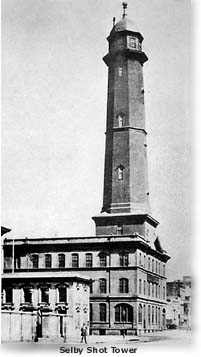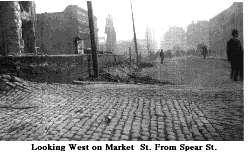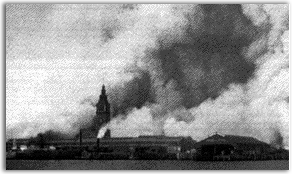|
||||||||||||||||
Thomas Jefferson Chase, a Ferry Building ticket clerk and telegrapher, was on First Street, on his way to work, at the time of the earthquake. This is his dramatic eyewitness account. The morning was clear and bright, not a breath of air was stirring. The city was asleep. The time was 5:18, morning of April 18th. 1906. I was working the early morning shift at the Ferry Building as telegrapher and ticket clerk. An operator named Gibbs worked the later, afternoon shift. He and I roomed together in a private home out on Folsom Street. My alarm clock jingled, but I didn’t get up. He called me several times, then said he would come over and pull me out. Something seemed to be holding me back. There were no Owl cars those days, so I usually walked down Folsom Street to First, thence to Market Street to eat before going to work. I had reached about halfway to Howard on the west side of First Street when I heard a low distant rumble. It was coming from the west. louder and louder. I stopped and listened. Then it hit. Power and trolley lines snapped like threads. The ends of the power lines dropped to the pavement not 10 feet from where I stood, writhing and hissing like reptiles. Brick and glass showered about me.
As this shock stopped I crossed over to the east side of the street. By this time the power lines were dead. As soon as I reached the curb a second shock hit. This was harder than the first. I was thrown flat and the cobblestones danced like corn in a popper. More brick and glass showered down on the sidewalk. As on the west side of the street these buildings were all one story. if I had been a block or two further down on First Street I would not be here today. As soon as it subsided I started for Howard Street. By the time I reached the corner a third shock hit. I was under the old [Selby] Shot Tower, I got out of reach of the tower. I expected to see it go. but it didn’t. The flag pole on the building whipped and snapped like the popping of a whip, On Howard Street was a row of frame cheap apartments. The outside wall of one building was In the street exposing the rooms like a doll house. A few people were in the street in their night clothes and barefoot, crying, moaning and wringing their hands. I started down Howard for the Ferry. Looking down First Street through the dust of demolished buildings a wisp of black smoke was rising through the dust. It appeared down near Market Street. This was one of the beginnings of the conflagration that destroyed the main part of the City. A little way down on Howard Street I met a man who asked where the explosion was, When I told him it was an earthquake he yelled and started running up Howard Street. I guess he thought he could beat it if another shock hit. A little way further on I met a fireboy. He asked me if I had seen any horses. I had not. He said fires were breaking out and they couldn’t get their equipment out. By that time more fires were in evidence.
The entire south wall of the Ferry Building was out. It crashed through the driveway down into the Bay. The waves were lazily lapping at the pilings as if nothing had happened. The boats had backed out into clear and were coming back into the slips again. One gateman was there and I asked him if he thought we could go to work. We went to the office and found the counters and floor covered with plaster. Everything was wet from broken pipes. but water had stopped running as mains had been broken somewhere along the line. A captain came in and sized up the situation. We decided to get busy and busy it was. We got the first boat out around 6:20. only 20 minutes late; then we resumed normal schedule. Then I tried the telegraph and telephone lines. They were dead. I wanted to try to get my mother over in Oakland as I feared for her safety; and also wanted to got the office at Oakland Pier. I had no idea the cable would be out of commission, but it was. By 7:00 a.m. the crowds were coming in. Many of them wanted main line tickets. but I had no time for that. I sold them ferry [tickets] in order to keep the crowds moving as the fire was spreading fast. The crowds were gathering fast in the Embarcadero, carrying bundles. suitcases and anything to gather up a few personal belongings. They began dropping them on the pavement while waiting to got out. This pile grew until it was like a hay stack. it was started just west of the car tracks on the Embarcadero where the Mission cars stopped. The people all seemed to be in a dazed or stunned. After leaving their bundles they apparently gave no further thought to them Another lighter shock occurred a little while after 8:00 a.m. [8:14 a.m.] The crowd surged back away from the Ferry. I closed up quickly and got out into the street. By that time, just a few seconds, it was over and no further damage to the Ferry Building. Around 9:00 a.m. another man showed up. He was due on duty at 7:00 a.m. His head was bandaged, having been hit by a brick from the chimney that came through the roof. And after that he walked five miles to get to the office. By 10:00 a.m. another one of the men showed up. As soon as he got under way I took a few minutes breathing spell. By that time Mission Street was a raging inferno. The mail car was about middle way up the first block and burned to the tracks. Some man had thought to saved his delivery wagon. He got it just over the curb and had to leave it there. It was blazing merrily when I looked up Mission. The street was like looking in the door of a furnace. Flames and smoke rolled with the draught created by the intense heat, rolling up the street with a roar, then up hundreds of feet. It was an awful sight. Returning to the office in a few minutes, first aids [injured victims] were coming, adding to the confusion and the crowds already there. Some had heads, arms, hands, legs and feet bandaged. Of course only those able to walk got down to the Ferry. It was not long until the buildings along the Embarcadero were ablaze. A raging inferno across from the Ferry. The pile of personal belongings ignited and in a short time that was a pile of ashes. You can imagine how intense the heat was outside.
Hose lines had been run through the Ferry Building and across driveways to Embarcadero. A bucket of water would have done as Much good. This was for only a short time as the heat became so intense no one could got close enough to do any good. The water just went up in steam and they had to give up. We had gotten the crowd pretty well thinned out by the time Market Street got to going good as well as the buildings on the north of the Embarcadero. The heat was intense and we momentarily expected the wharves and the Ferry Building to ignite. We locked everything in the vaults and closed up shop. Then we opened the gates to what was left of the crowd get in to safety and the boats. My roommate showed up about that time. He came by the office. He was traveling light as he had lost his clothing. He was black and dirty and had a wild look In his eyes. He was a fair sample of the crowds I had been handling all morning. He went on the boat and that was the last time I ever saw him.
After we closed shop I went out on a boat to get some breakfast. The boat pulled out and I was on my way home. All morning I worried about my mother and grandmother who were living in Oakland. They were found OK but they had seven hours of deep anxiety until I arrived a little after noon.
|

 Buildings along First Street from Howard to Market crumbled like card houses. One was brick. Not a soul escaped. Clouds of that obliterated the scene of destruction. The dust hung low over the rubble in the street.
Buildings along First Street from Howard to Market crumbled like card houses. One was brick. Not a soul escaped. Clouds of that obliterated the scene of destruction. The dust hung low over the rubble in the street.
 No street was clear through to Market Street until a couple of blocks west of the Embarcadero. When I got to Market Street I noticed the pavement had disappeared, a depression where here should have been pavement in sight. I went back and around and saw that the pavement had dropped fully five feet. The cable slots were compressed until they looked like a solid piece of steel all the way between the rails. I finished my trip to the Ferry in the middle of the street. I was safer there.
No street was clear through to Market Street until a couple of blocks west of the Embarcadero. When I got to Market Street I noticed the pavement had disappeared, a depression where here should have been pavement in sight. I went back and around and saw that the pavement had dropped fully five feet. The cable slots were compressed until they looked like a solid piece of steel all the way between the rails. I finished my trip to the Ferry in the middle of the street. I was safer there.
 Then the fire jumped Market Street. A little wisp of smoke curled up from a window casing on one of the floors of the old Terminal Hotel on the north side of Market, then other buildings on both sides of the Terminal. Within a half hour’s time Market Street was going good. It was not long until all avenues of escape were cut off from the Ferry Building.
Then the fire jumped Market Street. A little wisp of smoke curled up from a window casing on one of the floors of the old Terminal Hotel on the north side of Market, then other buildings on both sides of the Terminal. Within a half hour’s time Market Street was going good. It was not long until all avenues of escape were cut off from the Ferry Building.